What are Digital Kamishibai Boards?
Kamishibai boards are a visual control tool, used to perform audits for various processes. The method was popularised by the Toyota Production System (TPS). Audits are carried out regularly as per the schedule allocated to each individual. It ensures that audits are performed consistently and monitored regularly.
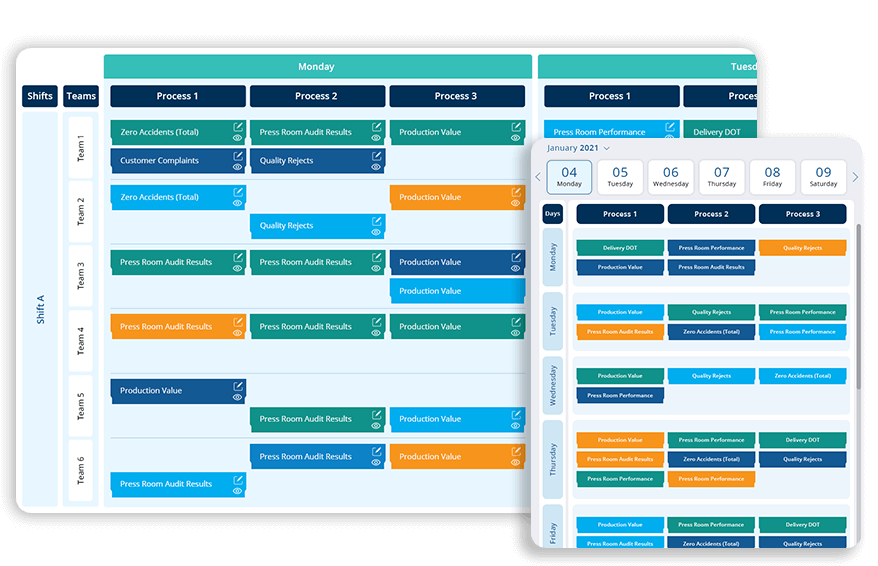
Kamishibai for Process Confirmation
Standardise daily, weekly and monthly audits using Digital Kamishibai Boards. Process Confirmation is a systematic audit process to check whether the work is done according to the standards and control points. These audits lead to productive discussions and insights on actions to be implemented.
Try Process Audits for free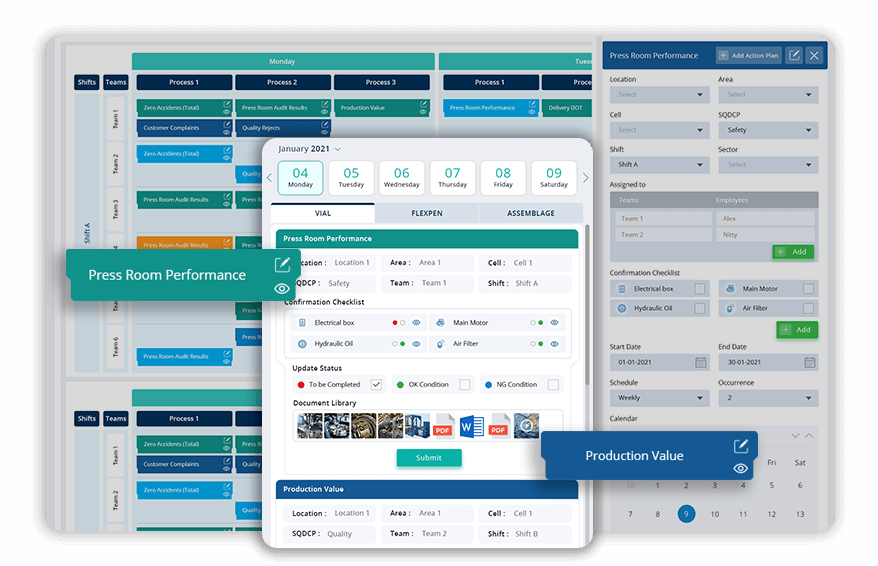
Streamline your Daily Management with Kamishibai Process Audits
Take control of your production goals with Kamishibai Process Confirmation Boards. Track your progress, identify off-track goals, and take corrective actions seamlessly. Make sure your improvements are sustained and maintain visibility of your operations at all times.
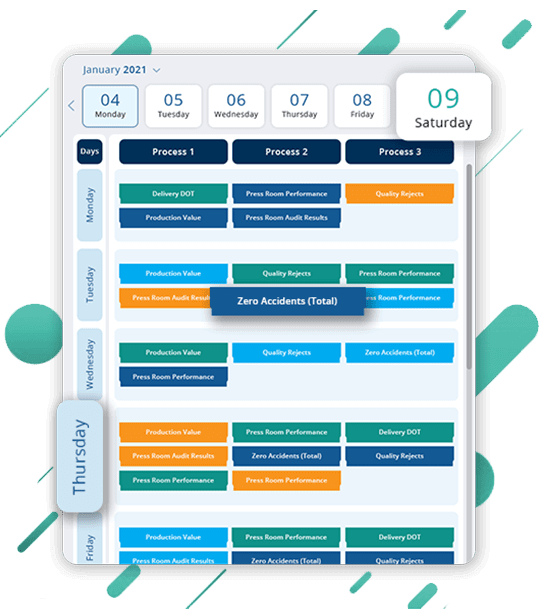
Standardise Daily, Weekly and Monthly Audits with Kamishibai Software
Schedule, allocate and execute audits. Assign responsibility to individuals, track progress of the audits, initiate and implement corrective measures. Create tasks in a Click! No more delayed audits, get it done on time.
- Easily Allocate and Execute Audits
- Initiate Action Plans
- No More Delayed Audits
- Continuous Monitoring of Processes
Origin of Kamishibai
Origin of Kamishibai, (kah-mee-she-bye) or “paper-theater,” can be traced back to the early 1930s in Japan. It is a tradition of picture storytelling, in which the audience saw and heard what happened to characters in the story and compared their lives to the characters in the kamishibai story; similar to self-audit. The same concept is applied in the Kamishibai board system where an audit is conducted against a set standard for each process.
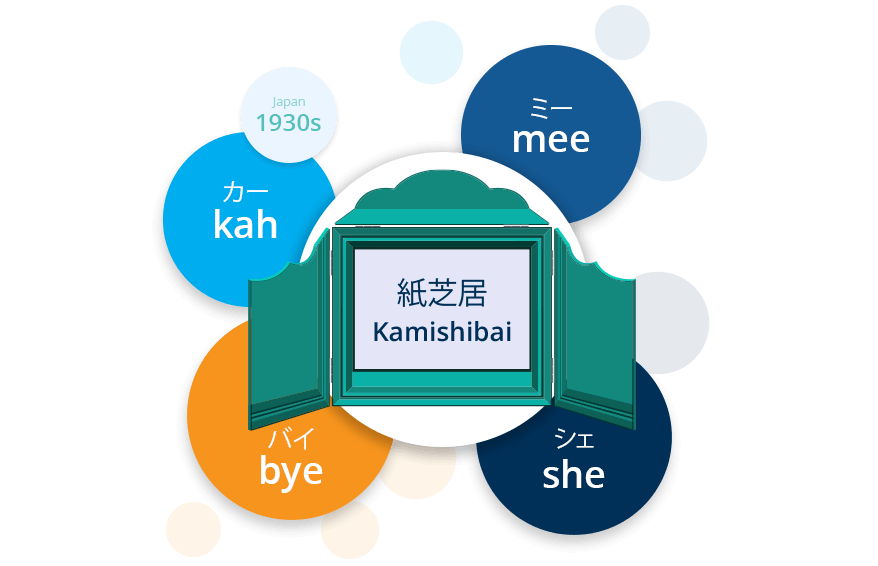
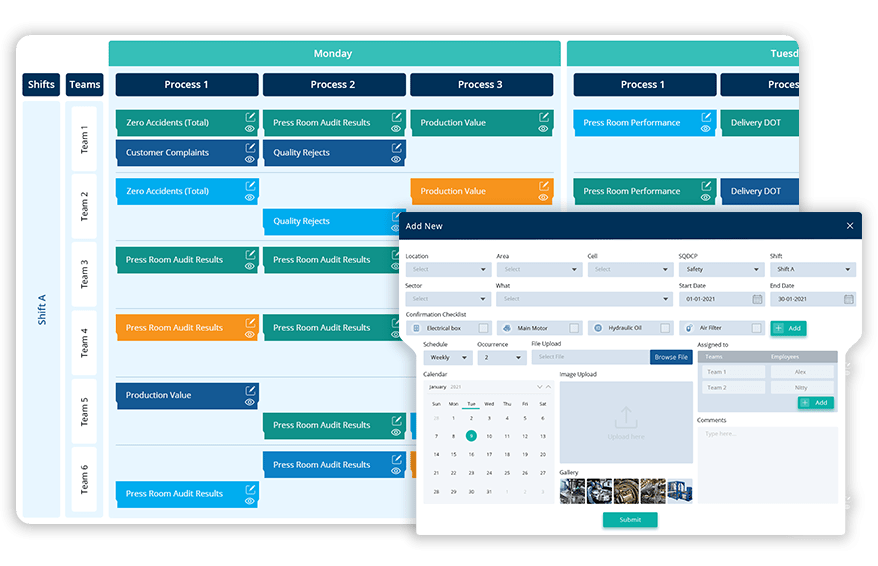
Kamishibai Cards
Kamishibai Cards contain information on what to be done, by whom, when and how for confirming process integrity. Audits are assigned and monitored regularly. These audits give insight on the ongoing processes. As the audit progress status of cards can be changed and updated.
Kamishibai & Gemba Walk
Gemba walks help you understand the ground level reality and the problems faced. Gemba walks maintains Lean practices and drives further improvement within the organisation. Digital Kamishibai board gives an overview of the processes to help structure every part of Gemba walk. Use Kamishibai Boards to get the job done at the right time.
Discover how it Works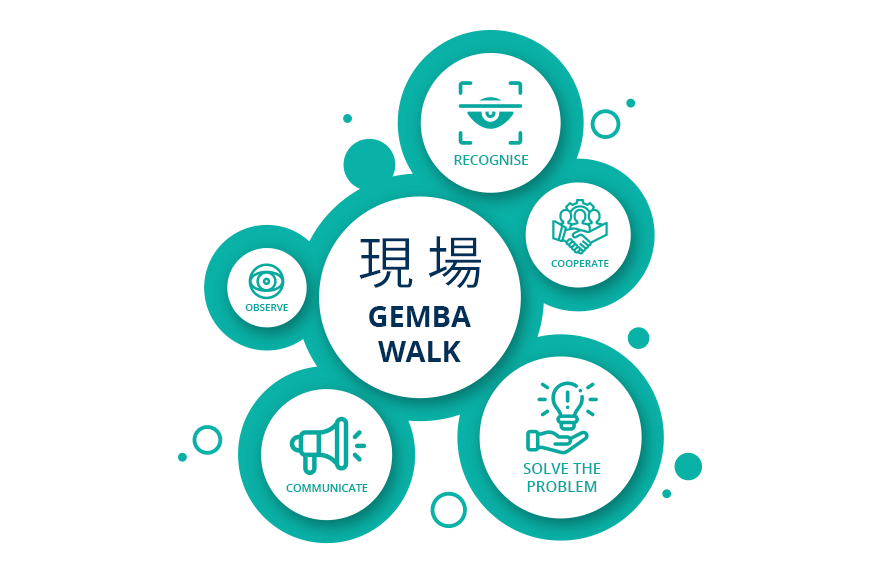
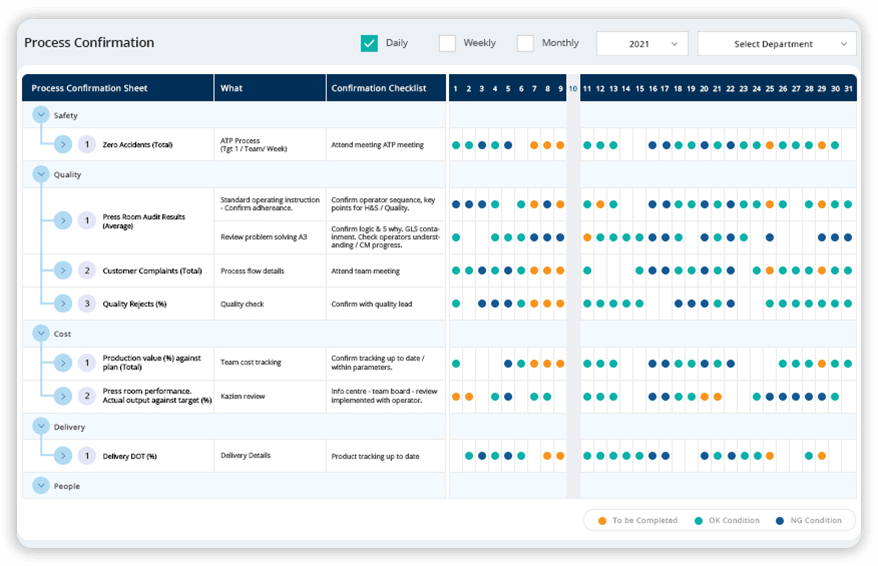
Kamishibai a Form of Total Preventive Maintenance
In Total Preventive Maintenance (TPM) regular checkups are done to prevent machine breakdowns. Likewise, regular Kamishibai audits identify slipping standards within each process and ensure smooth functioning of the Lean Management System.
Start Free TrialContents
- Kamishibai in Lean
- Where is the Kamishibai board located?
- What information do the Kamishibai boards contain?
- What is a kamishibai's primary purpose, and what is it used for?
- How does Kamishibai work?
- What is a Kamishibai audit system?
- How does Kamishibai add structure to Gemba Walks?
- Kamishibai is a form of Preventive Maintenance.
- What is a kamishibai?
- What is a Kamishibai board?
- What is Go to Gemba?
- What is Leader Standard Work?
- Why is kamishibai a vital lean tool for manufacturers?
- How do Kamishibai boards link to Leader Standard work?
- How can Kamishibai boards encourage continuous improvement?
- Does the Kamishibai board provide a template for Gemba walks?
- How to enhance your production efficiency with Kamishibai boards?
- Why use a Kamishibai board?
- Does Kamishibai differ from Kanban boards?
- How do Kamishibai boards promote accountability and improve task management?
- How can Kamishibai boards simplify the auditing process and ensure regulatory compliance?
- How do Kamishibai boards enhance transparency and visibility in process management?
- What advantages do Kamishibai boards offer in terms of standardisation and consistency?
- What impact do Kamishibai boards have on communication and collaboration among team members?
- How do Kamishibai boards enhance the tracking and monitoring of work orders?
- What role do Kamishibai boards play in improving decision-making through data analytics and performance metrics?
- How can Kamishibai boards enhance the documentation of work order details and associated information?
- What benefits do Kamishibai audits offer regarding the prioritisation and scheduling of work orders?
- What role do Kamishibai lean management play in promoting a proactive approach to compliance management?
What is kamishibai in lean?
Kamishibai in lean is a visual control centre in the workplace used for performing audits within a manufacturing process. A series of cards are placed on the visual control board. The green card indicates that everything has gone well and the task has been completed, and the red card indicates that the task still needs to be completed and requires attention. Kamishibai boards ensure the workplace's safety and cleanliness are maintained and the quality checks are performed well.
Where is the Kamishibai board located?
Kamishibai boards are usually located near the workplace within the visible range of the process in the audit scope. Kamishibai cards deliver vital information at a glance as they can provide information on the processes happening on the factory floor.
What information do the Kamishibai boards contain?
Kamishibai cards contain information on what to do, by whom, when and how to confirm the integrity of the process. These kamishibai cards thus give insights into the ongoing operations, and with the progress of the audits, the status of the cards gets updated.
What is the use of a Kamishibai board?
The proper use of Kamishibai is to train the eyes to see problems which can be deviations from the standard and identify the improvements even when they are still small and teach others to see and solve these problems. Kamishibai is a way to make the process standardised, visible and easy to do on the Gemba. They are the practical visual control lean tools that assist with allocating, sequencing, executing, and following essential work routines and tasks.
How does Kamishibai work?
Kamishibai is a lean visual management tool of process confirmation that plays a vital role in the daily management system. Kamishibai boards are similar to an hour to hour production status boards used by supervisors and line managers. Each card on the board contains the task details that must be checked during the Gemba walk and is double-sided with green and red colours on either side. The supervisor reviews the audit checklists and inserts the green-coloured side for the processes completed and red otherwise.
What is a Kamishibai audit system?
Kamishibai boards are used as a visual control lean tool for performing audits within a manufacturing process which Toyota Production System popularised. Cards placed on the board are selected randomly or according to the schedule of the supervisor and managers of the area. The card system helps to ensure that the audits are performed consistently, the safety and cleanliness of the workplace, such as 5S, are maintained, and the quality checks are being performed.
How does Kamishibai add structure to Gemba Walks?
Gemba walks in lean manufacturing is a robust way of bringing the leaders' attention to supporting the front line issues. Without strong visual controls and standards, the aim of the walk will not be fulfilled. The Kamishibai board can be one solution to structure the Gemba walk so that the leaders can perform the process confirmation of key standards daily. Kamishibai process standardises and prescribes weekly, monthly or quarterly standard works for the managers to examine and audit.
What role does Kamishibai play in preventive maintenance?
In Total Productive Maintenance, systematic equipment checks are done to prevent machine breakdowns. Kamishibai audits can detect slipping standards and help to avoid the downtime of the lean management system. Kamishibai can perform daily, weekly or monthly checks, which are otherwise done by the different levels of management. Kamishibai audits management systems and standards and hence also take the role of Preventive Maintenance.
What is a kamishibai?
Kamishibai is a process confirmation technique that forms an essential part of the lean daily management system. Kamishibai boards are visual management tools similar to the hour-to-hour production status boards. Kamishibai boards perform daily, weekly, monthly or quarterly audits.
What is a Kamishibai board?
Kamishibai board is a lean management tool that can visualise the data in your operations, keep track of your goals, take corrective measures and check whether the improvements made are sustained. It audits various processes, which are performed consistently and monitored regularly.
What is Go to Gemba?
"Going to Gemba" is visiting the factory floor and getting a real-time understanding of what is happening at every level. Gemba walk is a workplace walkthrough that aims to monitor the employees, get detailed insights into their tasks and determine productivity advancements.
What is Leader Standard Work?
Leader Standard Work is the set of management strategies, measures and skills that are incorporated into the manager's daily and weekly routine. It applies to the top-level leaders, supervisors, directors and executives who can facilitate the organisation's continuous improvement process.
Why is kamishibai a vital lean tool for manufacturers?
For the production process to operate effectively, the manufacturers need to deliver quality products. Kamishibai boards ensure that necessary process audits are taking place at regular intervals. By auditing the vital production processes at proper intervals, Kamishibai boards also provides the template for effective Gemba walks.
Book a Personalised Demo session to explore how your Production unit can benefit from Kamishibai Audit
How do Kamishibai boards link to Leader Standard work?
Kamishibai serves as a visual guide, reminding leaders of the areas to visit and create checklist items to observe the process and provides a platform to document and follow up on improvement opportunities.
Task Visualisation:
Digital Kamishibai boards display tasks, ensuring the leaders have a clear visual representation of their standard work activities. This helps leaders stay organised and ensures that the important tasks do not go unnoticed.Standardised Process Confirmation:
Leaders can create standard work instructions or checklists specific to their roles and responsibilities, which can be displayed on the Kamishibai boards for easy reference and completion.Daily Accountability:
Kamishibai boards promote daily accountability for Leader Standard Work. Leaders can assign specific tasks to themselves or team members, and the progress and completion of these tasks can be tracked on the Kamishibai board. Kamishibai ensures that processes are consistently performed and monitored.Continuous Improvement:
Leaders can use the Kamishibai boards to identify areas for improvement within their Standard Operating Procedures (SOPs), capture improvement ideas, and track the implementation of changes or experiments.Greater Visibility:
Kamishibai boards provide greater visibility regarding the execution of Leader Standard Work. By displaying tasks and their status on the Kamishibai boards, leaders and managers can easily see the adherence to Standard Operating Procedures (SOPs) and identify gaps or areas requiring support or intervention.PDCA Cycle:
Kamishibai boards serve as a platform for leaders to plan tasks, execute the tasks, check the outcomes or results, and take appropriate action based on the findings using PDCA (Plan-Do-Check-Act) cycle. This iterative process drives continuous improvement and ensures that Leader Standard Work remains effective.Training and Onboarding:
Kamishibai boards can assist in training and onboarding new leaders or team members. The boards can display the standard work orders and provide guidance or instructions, helping individuals understand their roles and responsibilities.
How can Kamishibai boards encourage Continuous Improvement?
Visualise Processes:
Kamishibai cards provide a visual representation of processes and workflows. Team members can better understand the sequence of activities when they visually map out the steps involved in a process. Kamishibai enhances transparency and encourages discussions around process optimisation.Standardise Work:
Using Kamishibai lean boards promotes standardisation by defining clear expectations and Standard Operating Procedures (SOPs). By visually displaying these standards, everyone involved can understand and adhere to the established guidelines. Standardisation enables teams to identify deviations from the norm, leading to discussions on improving and aligning with the standard.Daily Auditing:
Team members can use the boards to track and review tasks or activities performed throughout the day. Regular audits provide opportunities for identifying issues, variations, or gaps, which can be addressed and resolved promptly. This constant monitoring and feedback loop contributes to a continuous improvement mindset.Problem Identification and Resolution:
Kamishibai digital boards include cards that represent specific tasks or processes. Visual displays help teams quickly identify and resolve issues, ensuring they are noticed and addressed. Kamishibai board ensures timely problem-solving and prevents recurring errors.Employee Engagement and Ownership:
Team members can take ownership of their respective tasks by actively updating and maintaining the boards. This involvement empowers individuals to contribute ideas for process improvement and take responsibility for the outcomes. As a result, it fosters a sense of ownership, accountability, and motivation to drive continuous improvement efforts.Data-Driven Decision-Making:
Kamishibai boards can incorporate relevant performance metrics, such as cycle times, quality indicators, or customer satisfaction ratings. Hence the team monitors its performance and identifies trends and patterns that must be addressed. The availability of real-time data promotes data-driven decision-making, enabling teams to make informed choices for process improvement initiatives.Continuous Learning and Kaizen Mindset:
Through regular audits, problem-solving sessions, and feedback loops, team members can continuously learn from their experiences and make incremental improvements. The visual nature of Kamishibai boards also facilitates knowledge sharing, enabling teams to share best practices, insights, and lessons learned.
Does the Kamishibai board provide a template for Gemba walks?
Gemba walks are a Lean management practice where leaders and managers "Go to the Gemba" or the actual place where work is happening to observe, engage with employees, and gain first hand insights into processes and operations. Kamishibai boards can be designed and utilised as a part of the Gemba walk process to facilitate structured observations and discussions. The systematic approach helps ensure consistency and accountability in the Gemba walk process and enhances the effectiveness of Lean management practices.
Visualise Work Areas:
The Kamishibai board can be organised to represent different work areas or processes within the organisation. Each work area can have its dedicated section on the board, displaying relevant tasks and activities.Task Cards:
Each work area section on the Kamishibai board can contain task cards representing specific activities or tasks performed within that area. These cards can provide information about the task, frequency, Standard Operating Procedures, and associated performance metrics.Gemba Walk Schedule:
The Kamishibai board can incorporate a schedule or rotation plan for Gemba walks. It can specify the frequency and duration of Gemba walks for each work area, ensuring that leaders visit different areas regularly.Checklist and Observation Points:
Within each work area section, the Kamishibai board can include a checklist or observation points for the Gemba walks. These checklist items can cover key aspects such as safety, quality, efficiency, adherence to standard procedures, and employee engagement. Leaders can mark off or note observations during the Gemba walk.Feedback and Improvement:
The Kamishibai board can have a dedicated section for capturing feedback and improvement ideas during the Gemba walks. This section can serve as a space for leaders to write down their observations, suggestions, or issues identified during their Gemba walk. This feedback can later be discussed and addressed with the relevant teams.Action Plan and Follow-up:
The Kamishibai board can include an action plan section based on the observations and feedback gathered during Gemba walks. This section can document improvement initiatives, assign responsibilities, set deadlines, and track progress on addressing the identified issues or implementing suggested improvements.
How to enhance your production efficiency with Kamishibai boards?
Map the Production Process:
Start by mapping your production process and identifying the key steps involved. Understand the sequence of activities, dependencies, and potential bottlenecks. Process mapping will help you identify improvement areas.Analyse Performance:
Determine and compare your organisation's performance to improve production efficiency. It includes cycle time, throughput, scrap rates, downtime or Overall Equipment Effectiveness (OEE) metrics. Select the most relevant performance indicator for your specific production environment.Set Frequency and Schedule:
Analyse the frequency at which the Kamishibai board will be reviewed and updated. Regular intervals, such as daily or weekly, are typically effective. Create a schedule for reviewing the board and assign responsible individuals to conduct the audits.Daily Audits and Problem Identification:
Conduct daily audits of the Kamishibai board. Check if the tasks and processes are being performed according to the SOPs. Look for deviations, abnormalities, or areas where efficiency can be improved. Use visual cues, such as different-coloured cards or indicators, to highlight issues or bottlenecks.Problem-Solving and Continuous Improvement:
Initiate problem-solving activities when abnormalities or inefficiencies are identified during the audits. Encourage team members to actively participate in Root Cause Analysis (RCA) and propose improvement ideas. Implement countermeasures and monitor the impact of these improvements on production efficiency.Visualise Performance Trends:
Use the Kamishibai board to track and visualise performance trends over time. Monitor and compare them against the established targets. This visual representation enables easy identification of areas where improvements are needed and facilitates data-driven decision-making.Employee Engagement and Training:
Train employees on how to use the Kamishibai board effectively and engage them in problem-solving initiatives. Foster a culture of continuous improvement and provide recognition for employees who contribute innovative ideas or demonstrate exceptional efficiency.Regular Review and Updates:
Periodically review the effectiveness of the Kamishibai board and make necessary adjustments. Continuously refine the SOPs and tasks to align with changing production needs and improvement opportunities.
Why use a Kamishibai board?
There are several compelling reasons to use a Kamishibai board within an organisation.
Visual Management:
The visual nature of Kamishibai boards enhances clarity, comprehension, and transparency. It enables employees at all levels to quickly understand the status of tasks, identify abnormalities, and track progress.Process Improvement:
Kamishibai boards highlight deviations from standards, enabling prompt action and problem-solving. Kamishibai boards encourage data-driven decision-making and provide a platform for tracking improvement initiatives over time.Daily Auditing:
The daily audits performed using Kamishibai boards help to identify and address issues on time. Organisations can ensure that tasks and processes are consistently followed by incorporating scheduled checks and reviews, reducing the risk of errors, omissions, or quality issues.Employee Engagement:
Kamishibai provides a platform for employees to actively participate in the process, contribute ideas, and take ownership of their tasks. The visual display of tasks and performance metrics encourages a sense of responsibility and motivates employees to achieve their targets.Communication and Collaboration:
Kamishibai boards provide a centralised location for displaying information, updates, and improvement initiatives. They encourage communication around tasks, problems, and improvement ideas, facilitating collaboration and knowledge sharing.Efficiency and Productivity:
Kamishibai boards help optimise efficiency and productivity by providing visibility into tasks, workflows, and performance metrics. They identify bottlenecks, streamline processes, and enable timely problem-solving. The standardised practices and clear communication fostered by the boards contribute to improved operational efficiency.Focus and Prioritisation:
Kamishibai visually highlights tasks and associated deadlines, ensuring that important activities are not delayed. This focus helps teams stay on track and achieve their objectives.
Does Kamishibai differ from Kanban boards?
Kamishibai and Kanban boards are different systems used for visual management in different contexts.
Kamishibai Boards
- Origin: Originated in Japan as a storytelling method.
- Purpose: It is a visual control system used in lean manufacturing to ensure standardised work and maintain process adherence.
- Method: Kamishibai uses cards representing tasks or Standard Operating Procedures corresponding to each task performed or checked.
- Focus: Kamishibai emphasises process confirmation, error prevention, and continuous improvement.
Kanban Boards
- Origin: Originated in the Toyota Production System (TPS)
- Purpose: Kanban boards are used to manage workflow and track the progress of tasks or projects.
- Method: Kanban boards typically consist of columns representing different stages of work (e.g., "To Do," "In Progress," "Done") and cards representing individual tasks. The cards move across the columns as the work progresses.
- Focus: Kanban boards focus on visualising and optimising workflow, promoting collaboration, and managing work in progress.
Kamishibai is a visual control system for process adherence and continuous improvement, while Kanban boards are visual tools for managing workflow and tracking tasks or projects.
Read MoreHow do Kamishibai boards promote accountability and improve task management?
Clear Assignments:
Kamishibai boards in a manufacturing industry visually display the tasks and the details, making it evident who is accountable for completing each task. It clarifies possible confusion and ensures that everyone understands their role and responsibilities.Visual Tracking:
In Kamishibai boards, each task is represented by a card on the board, and its movement across workflow columns indicates its completion stage. The visual tracking system allows team members and leaders to stay on top of tasks, identify bottlenecks, and take appropriate action.Task Prioritisation:
Kamishibai boards often check due dates or timelines for task completion. This emphasis on time helps prioritise tasks and creates a sense of urgency, promoting accountability and preventing delays.Transparency and Visibility:
Kamishibai boards create transparency and visibility in task management. Team members can see the overall status of tasks, including their own and those assigned to others.Regular Reviews and Audits:
Team members and leaders can periodically review the board together, ensuring timely task completion and to the expected standards. These reviews provide opportunities to address issues, reassign tasks, and identify improvement areas.Performance Monitoring:
Kamishibai boards allow for performance monitoring and evaluation. By tracking task completion rates, cycle times, or Overall Equipment Efficiency (OEE), organisations can assess the efficiency and effectiveness of task management. This data-driven approach helps identify areas for optimisation and drives accountability for meeting performance targets.
How can Kamishibai boards simplify the auditing process and ensure regulatory compliance?
Kamishibai boards simplify the auditing process with their organised platform for documentation and record-keeping. The boards capture an accurate record of process steps, confirmations, and signatures, creating a traceable history that can be easily accessed during audits or inspections.
This eliminates the need for manual document retrieval or sifting through scattered records. The visual nature of Kamishibai boards allows auditors to navigate through the documented records seamlessly, ensuring a comprehensive assessment of compliance practices without unnecessary disruptions.
Kamishibai boards help organisations meet regulatory requirements by providing a clear framework for process confirmation, accountability, and documentation, ultimately streamlining the auditing process and ensuring regulatory compliance.
How do Kamishibai boards enhance transparency and visibility in process management?
Kamishibai boards enhance transparency and visibility in process management by providing a visual and centralised platform that displays each process step's status, progress, and details.
This enhanced transparency and visibility in process management facilitate better decision-making, timely interventions, and a proactive approach to addressing issues or optimising processes.
Team members can easily see the current state of tasks, identify bottlenecks or delays, and track the overall progress of the process. The boards promote transparency by making information accessible to everyone involved, eliminating silos and fostering collaboration.
What advantages do Kamishibai boards offer in terms of standardisation and consistency?
Clear Process Structure:
Manufacturing Kamishibai boards offer a structured approach to process management, featuring predefined workflow columns and clear process steps that promote consistency in task execution.Uniform Task Execution:
Kamishibai boards promote consistent task execution by providing instructions, checklists, or guidelines for each process step, minimising variations in task performance.Reduced Variability:
By standardising process steps and confirmation activities, Kamishibai boards help reduce outcome variability, improving overall quality and minimising errors or deviations.Alignment with Best Practices:
Kamishibai boards can incorporate industry best practices or established standards, ensuring that tasks are executed consistently with industry norms or regulatory requirements.Training and Onboarding Support:
Kamishibai boards act as a training and onboarding tool, enabling new team members to understand the standardised processes and follow the prescribed steps quickly.
What impact do Kamishibai boards have on communication and collaboration among team members?
Shared Visibility:
Kamishibai boards provide a centralised and visual platform that allows team members to have shared visibility into the status, progress, and details of tasks. This shared visibility promotes transparency and facilitates open communication among team members.Clarity of Responsibilities:
Kamishibai boards assign responsibilities for each task or process step, leaving no room for ambiguity. Team members can easily see who is accountable for which tasks, eliminating confusion and ensuring clear communication regarding roles and expectations.Real-Time Updates:
Kamishibai boards support real-time updates, allowing team members to provide immediate updates on task progress, completion, or any issues encountered. This real-time information sharing enables timely collaboration, problem-solving, and coordination among team members.Coordination of Efforts:
Kamishibai boards help coordinate efforts among team members by providing a clear overview of task dependencies and workflow. Team members can understand how their tasks align with others, enabling them to coordinate their efforts effectively and avoid bottlenecks or overlaps.Problem Identification and Resolution:
Kamishibai boards make it easier to identify problems or issues within the process. Team members can flag challenges or abnormalities directly on the board, initiating discussions and collaborative problem-solving to address them promptly.
How do Kamishibai boards enhance the tracking and monitoring of work orders?
Kamishibai boards provide a visual and centralised platform for tracking and monitoring work orders, allowing users to keep track of each work order's progress and status. The boards allow team members to easily track the movement of work order cards across different workflow columns, indicating their completion stage. This visual tracking enables real-time visibility into the status of work orders, identifies bottlenecks, and facilitates timely interventions. By providing a clear overview of work orders, Kamishibai boards enhance the tracking, monitoring, and coordination of work order management processes.
What role do Kamishibai boards play in improving decision-making through data analytics and performance metrics?
The Kamishibai boards can incorporate performance indicators, such as cycle time, lead time, OEE (Overall Equipment Efficiency) or defect rates, allowing team members to monitor and analyse data trends. By visualising this data, Kamishibai boards enable data-driven decision-making, helping teams identify areas for improvement, prioritise actions, and make informed decisions to optimise processes and drive performance. Integrating data analytics and performance metrics within Kamishibai boards enhances transparency, fosters a culture of continuous improvement, and supports evidence-based decision-making throughout the organisation.
How can Kamishibai boards enhance the documentation of work order details and associated information?
A Kamishibai board facilitates the documentation of work order details and associated information by providing a centralised and structured platform for capturing and displaying these details. Each work order card on the board can contain essential information such as work order number, description, due date, priority, assigned personnel, and any specific instructions or attachments.
This centralised documentation ensures that all pertinent details are readily available and accessible to team members. By visually organising and displaying the work order information, Kamishibai boards enable efficient documentation and easy retrieval of information and promote accuracy and consistency in recording work order details.
What benefits do Kamishibai audits offer regarding the prioritisation and scheduling of work orders?
The Kamishibai boards visually represent work orders, allowing team members to see the entire workload at a glance. This visibility helps prioritise work orders based on urgency, importance, or specific criteria. Organising work order cards on the board allows teams to easily adjust the sequence or prioritise tasks according to changing needs.
Lean kamishibai boards also facilitate efficient scheduling by displaying due dates, timelines, and workflow columns representing completion stages. This enables teams to effectively plan and allocate resources, ensuring that work orders are completed on time while minimising bottlenecks and optimising overall scheduling efficiency.
What role do Kamishibai lean management play in promoting a proactive approach to compliance management?
Kamishibai boards encourage a proactive approach to compliance management by providing a structured framework for documenting and confirming processes. The boards outline the required steps for compliance, ensuring that each task is completed consistently and accurately. By visually displaying compliance-related processes and associated confirmation activities, Kamishibai boards create transparency and awareness among team members, promoting a culture of adherence to regulations and standards.
The boards also remind of compliance requirements, prompting teams to address deviations or non-compliance issues proactively. By integrating compliance activities into the daily workflow, Kamishibai boards help organisations stay vigilant and proactive in meeting regulatory obligations, reducing the risk of non-compliance and fostering a compliance-focused mindset.
Other T Card Features
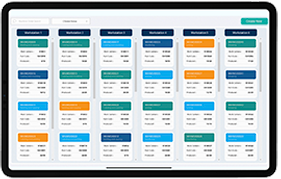
Interactive Drag and Drop T-Cards
Simplify the overall process! Click and move your tasks from one stage to another.
Read More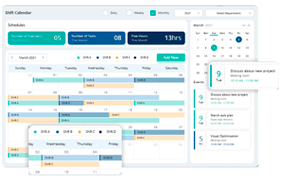
Schedule & Prioritise Events
No more waiting! Schedule and Prioritise tasks on the go. Set different priority levels for each task...
Read More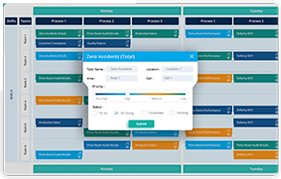
Configurable TCard Features
Cards of your Choice! Get multicolour cards, assign tasks and see the history of each task and process in detail.
Read More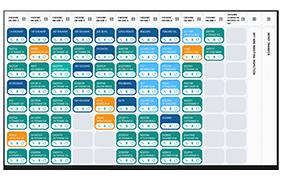
Mobility & Global Accessibility
Access T card software anytime from anywhere! Explore more on tcard Mobile, iPad, and Web applications.
Read MoreInnumerable
Reports and Analytics
Get auto-generated reports and summaries in a click! Gather meaningful insights, to improve business performance.
Read More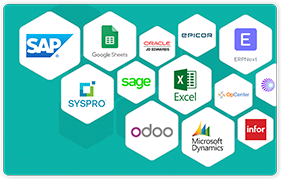
Easy
to Integrate
Easier than ever to integrate with ERP and MES Systems. Access and centralise real-time information.
Read MoreReady to Implement Digital Kamishibai Boards?
Take the next step in streamlining your processes and improving accountability with our powerful digital Kamishibai boards. Get started today to enhance your team's efficiency and performance.



